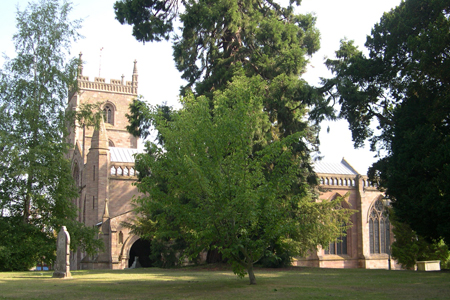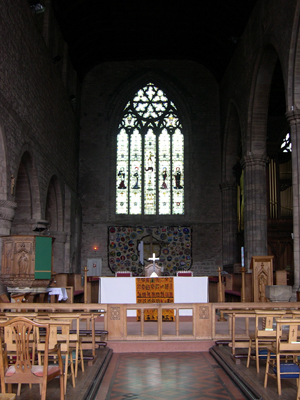| |
 |
 |
 |
| Comment on this report, or find other reports. |
 |
| Our Mystery Worshippers are volunteers who warm church pews for us around the world. If you'd like to become a Mystery Worshipper, start here. |
 |
| Find out how to reproduce this report in your church magazine or website. |
|
|
| 1991: The Priory Church of St Peter and St Paul, Leominster, England |
 |
 |
 |
Mystery Worshipper: Chris Teean.
The church: The Priory Church of St Peter and St Paul, Leominster, Herefordshire, England.
Denomination: Church of England, Diocese of Hereford.
The building: The priory is one of Herefordshire's largest and oldest religious buildings, and is classed as one of the finest parish churches in England in the book, England's Thousand Best Churches. On entering through the south porch you become aware that this lofty, broad church is unusual because it appears to have three naves. St David founded a religious community here in the 6th century, and there has indeed been a church on this site since 660. In Norman times, the priory was home to a Benedictine community of monks attached to the royal monastery at Reading. When the monastery was dissolved in 1539 on the order of Henry VIII, the parts of the church used by the monks were demolished, but the rest of the building became the parish church. Then in 1699, a devastating fire destroyed the roof, window glass and much of the furnishings. Tuscan pillars were installed, but in the later restoration work undertaken by Sir Gilbert Scott (between 1860 and 80), they were replaced with a slender Gothic arcade, creating a feeling of space. At the end of the south aisle is a splendid looking organ, and next to this is a rood screen through which can be seen the Lady Chapel. A very modern feature is the eye-catching "sea of faith" tapestry, consisting of roundels that represent various local groups, which hangs below the magnificent east window depicting the crucifixion. There are windows in a similar style along the south side, some by Kempe, depicting the annunciation, the birth of Jesus, the visit of the magi and the presentation in the temple. The great 45-foot perpendicular west window shows St Peter and St Paul, the priory's patron saints. A ducking stool, last used in 1809, can be seen in the Norman nave, which also contains a rather faint medieval painting of the wheel of life at the back of the church.
The church: Holy Communion is celebrated several times every Sunday and there are other services throughout the week. They have numerous societies and clubs, listed in the porch and in their magazine. I was surprised that a church this size didn't have its own website, when it seemed to have as much going on as many a cathedral. The church also hosts many concerts, and indeed your Mystery Worshipper was overjoyed with a concert that same evening put on by the Leominster Choral Society, as part of the week-long Leominster Festival. Many tears of emotion and joy were shed during an exquisite performance, which included Allegri's Misere and Mozart's Laudate Dominum, Magnificat and Requiem Mass.
The neighbourhood: The large ancient stone church with its low, square Norman tower is reached in just a few minutes walk from the centre of the small town of Leominster (pronounced "Lemster"). It sits by the River Lugg in the heart of the Marches, the beautiful borderlands of England and Wales. The town dates from the 6th century and has retained many medieval and Tudor characteristics as well as very narrow streets, but it receives top marks from me as being motorist friendly (unusual in this day and age), by providing a large free car park close to the church.
The cast: The celebrant was the Revd Mike Kneen and the preacher was Dr Paul Scott. They were assisted by a lay assistant, Mr Peter Wingrave.
The date & time: Sunday, 6 June 2010, First Sunday after Trinity.
What was the name of the service?
Family Communion.
How full was the building?
I would say there were at least 100 people there, predominantly middle aged or elderly. But the strange thing was that I didn't see any children at all, which I thought was rather unusual for a family service. If they were at a Sunday school, I would have expected to see them for at least some part of the service.
Did anyone welcome you personally?
Yes, we were welcomed profusely by several people and were handed all the books we needed for the service.
Was your pew comfortable?
It was a chair that was reasonably comfortable, with a hassock stowed under the chair in front, which also housed a slot for books and leaflets. There was plenty of room for kneeling.
How would you describe the pre-service
atmosphere?
There was a lot of quite loud chatter as people greeted each other. The organist played some introductory music.
What were the exact opening words of the
service?
Following a welcome, especially to all visitors: "So now we meet as friends. In the name of the Father, and of the Son, and of the Holy Spirit. Amen. Grace, mercy and peace from God our Father and the Lord Jesus Christ be with you."
What books did the congregation use during the
service?
A service booklet, The Eucharist for Ordinary Time and Saints Days, the priory church newsletter, and a hymn book, Complete Anglican Hymns Old and New.
What musical instruments were played?
A rather magnificent pipe organ. The present organ by the Worcestershire firm of Nicholson was built in 1927 and has been restored and added to many times over the years; there is currently an appeal to renovate it following rain damage from a leaking roof. Despite its limitations, it was played expertly by the resident organist and choirmaster, Vernon Thurgood, a winner of the "Elgar in Hereford Music Award" and conductor of the Leominster Choral Society for over 40 years.

Did anything distract you?
I couldn't help looking at the different nave areas brought about by the priory's diverse, ancient lineage. It was quite extraordinary that your eye could travel from Norman austerity to a decorated Gothic style in a few seconds. The crooked ceiling and marks of a previous archway above the chancel made me wonder at how it had all been done.
Was the worship stiff-upper-lip, happy clappy, or
what?
I was very impressed by the start of the service, where the choir stood in the Norman nave and sang the introit. A crucifer led the dignified procession of robed choir, taperers and three clergy, and the celebrant was vested in a green chasuble while the others wore white albs. However, apart from some bowing and crossing at appropriate times, there did not appear to be any other signs of reverence, so my overall impression was that it was rather middle of the road Anglicanism.
Exactly how long was the sermon?
16 minutes.
On a scale of 1-10, how good was the preacher?
6 – He seemed to be delivering an academic treatise. Having written it before the tragic shootings in Cumbria that had occurred four days earlier, he believed the text was still relevant, although I am afraid it was lost on me.
In a nutshell, what was the sermon
about?
It was about the difference
between secular humanism, with its blind, fickle optimism, and Christianity, which does not have an optimistic view of human beings. In today's society, secular humanism is much more attractive than Christianity, because it sets humanity at the centre of existence. Christianity speaks about the possibility of redemption and God's promise of eternal life.
Which part of the service was like being in
heaven?
The singing of the final hymn, "Thine be the glory", sung enthusiastically by both choir and congregation in such a stunning setting, sent shivers down my spine and brought tears to my eyes as I realised that hymns of praise had been sung on this spot for so many years.
And which part was like being in... er... the other place?
This is always a hard question to answer when you are enjoying the worship at an unfamiliar church. I think the only niggle I felt was when we were invited to recite the prayer our Lord taught us to pray. Well, I am sorry, but the version of the Lord's prayer I was taught was not in modern language!
What happened when you hung around after the service looking lost?
Many people engaged us in conversation and we were able to have a long chat with the celebrant. The place was a hive of activity as people prepared the seating and catering for the forthcoming evening concert.
How would you describe the after-service
coffee?
It was cheerily served in a cup and saucer and there was a selection of biscuits.
How would you feel about making this church your regular (where 10 = ecstatic, 0 = terminal)?
9 – I think this church would be number one on my list if I came to live in the area.
Did the service make you feel glad to be a
Christian?
Undoubtedly. It was uplifting to be part of a congregation that obviously enjoyed its worship in such wonderful surroundings.
What one thing will you remember about all this in seven days' time?
The singing of the choir, particularly that of the introit and during communion, was absolutely superb and made full use of the wonderful acoustics of the building. |
|
|
 |
 |
 |
| We rely on voluntary donations to stay online. If you're a regular visitor to Ship of Fools, please consider supporting us. |
 |
 |
 |
| The Mystery Pilgrim |
 |
| One of our most seasoned reporters makes the Camino pilgrimage to Santiago de Compostela in Spain. Read here. |
 |
 |
 |
| London churches |
 |
| Read reports from 70 London churches, visited by a small army of Mystery Worshippers on one single Sunday. Read here. |
| |
|
|
|
|


